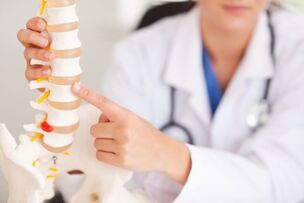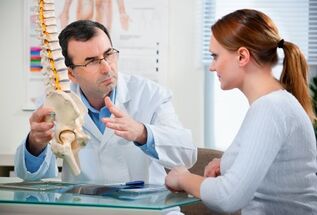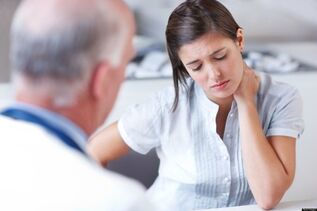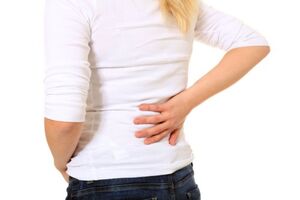
Everyone, at least once in their lives, has had problems when their back hurts in the lower back. This symptom usually appears after sitting in an uncomfortable position for a long time. Pain is safe for health and disappears after a good rest.
Treatment can be prescribed only after a complete diagnosis and determination of the cause and nature of the disease. No action can be taken on its own without a medical examination.
Variety of reasons
The most common causes of pain are: osteochondrosis, scoliosis, herniated disc. Tumors and tissue infections are much less common.
Pain manifests itself in different ways depending on the disease. If the cause of the pain is renal colic or a stomach ulcer, the sensations will be constant, regardless of the nature of the activity (the person is lying down or doing vigorous activities).
If there is osteochondrosis of the thoracic region, the pain radiates to the heart and the patient mistakenly believes that he has angina pectoris.
If your lower back hurts while lying down
When the pain appears and the person does not know what to do with it, he prefers to lie down, waiting for the discomfort to go away. But if the pain intensifies while lying down, there is likely to be a disease of the musculoskeletal system, called ankylosing spondylitis.
The disease affects young men, changes occur in the vertebrae and they grow together, while the flexibility of the spine decreases.
Because the spine does not assume its natural position, the person feels pain when lying down.
Ankylosing spondylitis is hereditary; chronic infectious diseases drive their development. The pain increases if you lead a sedentary lifestyle.
The first sign is a feeling of stiffness in the spine and, if you lie down, the back pain gets worse. Early diagnosis can completely cure the disease.
Primary pain syndrome

Doctors distinguish between primary and secondary pain syndromes when it comes to back and lower back pain.
Primary low back pain syndrome involves musculoskeletal changes of a morphofunctional nature.
These are the most common causes of pain:
- osteochondrosis (damage to bone and cartilage tissue, intervertebral disc);
- spondyloptosis (lesions in the intervertebral joints that affect the mobility of the spine).
Secondary pain syndrome
Secondary syndrome includes a wide variety of conditions that cause back pain in the lower back:
- scoliosis
- (curvature of the spine);
- reflected pain;
- osteoporosis and osteomalacia (damage to bone tissue);
- ankylosing spondylitis (inflammation of a non-infectious nature);
- rheumatoid arthritis;
- isolated tumor or metastases formed;
- tuberculosis, epidural abscess, brucellosis (infectious diseases);
- condition of stroke that leads to impaired cerebrospinal circulation;
- gastrointestinal diseases (in particular, appendicitis or intestinal disease);
- diseases in the pelvic region (renal colic, venereal diseases);
- fracture of the spine (the most dangerous and serious cause).
Acute pain
Low back pain is also classified as acute and chronic. Each of them points to different reasons.
A harmless but painful manifestation of acute pain is muscle sprain. It occurs due to the formation of spasms in the long muscles.
Athletes and people with specialties of work suffer more frequently. The pain is located in the lower back, but is clearly felt in other parts of the body, while a person's mobility is limited, lying down the pain decreases.

Spinal injuries also cause acute pain. The most dangerous injury is a fracture of the spine.
The fracture can be caused by a fall or it can occur completely unnoticed, for example, if the person has Paget's disease, osteoporosis, hyperparathyroidism or has a tumor.
The displacement of the intervertebral discs in the lower back also causes pain. In that case, a person's mobility will be severely limited.
Pain itself is caused by compression of nerve roots. Additional symptoms:
- violation of sensitivity;
- decrease or complete absence of Achilles and knee reflexes;
- root pain.
The displacement of the vertebrae can lead to the pathology of close people, who were healthy until the end. Disorders of the lower vertebrae lead to diseases of the bladder and intestines.
Another reason for acute pain is facet syndrome. In this case, the intervertebral disc is not affected, there is only compression of the root, which leaves the vertebral canal. The intervertebral foramen narrows due to the narrowing of the intervertebral foramen.
A serious illness, such as an epidural abscess, can also cause pain. What to do in this case?
The disease should not be delayed, as it can lead to tragic consequences. It is necessary to take all measures immediately to eliminate compression of the spinal cord, sometimes surgical intervention is necessary.
In the region from the lower back to the knees, pain caused by diseases of the hip joint may occur.
Chronic pain
If the back is diseased in the lower back and the pain is constantly present, painful or pulled by nature, this indicates other diseases besides acute pain.

The first reason is deforming spondylosis. The lumbar spine vertebrae undergo dystrophic changes, the ligaments weaken and bone growth begins.
As a result, bone growth begins to put pressure on nerve roots and painful pain occurs. Numbness and weakness in the legs can add to the symptoms.
Chronic low back pain can be caused by cancer or metabolic disorders.
In this case, you need to do anticancer therapy, change the daily regimen and diet to eliminate the root cause, everything else will be ineffective.
Another reason is osteomyelitis, when an infection penetrates the bone and causes inflammation.
Diseases that cause low back pain
Other conditions that cause low back pain
- facet arthropathy;
- spinal stenosis;
- herniated disc;
- myogenic pain;
- rupture of the fibrous ring.
In women, pain can be triggered by diseases of the pelvis, such as endometriosis, uterine and ovarian carcinoma. In men - prostatitis or prostate carcinoma.

Sick kidneys, a tumor in the stomach, duodenum can also be transmitted to the lower back. Pain occurs with ulcerative colitis, colon tumors, diverticulitis.
If the pain extends not only to the lumbar region, but also to the thoracic region, it is important to exclude the possibility of aortic dissection.
Harmless causes can be physiological changes, for example, the postpartum period or a marked increase in mass, the effect of epidural anesthesia.
The treatment of this pain is not carried out, the patient cannot do anything, the pain will go away on its own after a certain time.
Treatment of the lumbar spine
Before starting treatment, you need to make a correct diagnosis. First, the doctor performs a clinical examination of the patient and then trusts the results of the ultrasound and MRI scans.
Based on the diagnosis, a treatment program is already being selected, combining several methods.
First, the treatment aims to eliminate the painful syndrome in order to return the patient to a comfortable life. After all, the complete cure of the disease (if possible) can take years.
If a bruise is the cause of the disease, a traumatologist will do the treatment. Depending on the cause of the pain, which the therapist / family doctor must identify, an orthopedist, nephrologist, urologist, proctologist, gynecologist, cardiologist, gastroenterologist, pulmonologist, specialist in infectious diseases can maintain a later history of the disease.
Previously, back pain was treated exclusively with antibiotics. Now, there are so many treatment methods that only an experienced doctor will help you choose the right one.
To relieve the patient's condition, it is recommended to replace the mattress with an orthopedic one. The pain will be eliminated through ointments and anesthetic warming gels, which additionally contain anti-inflammatory components.
The use of non-steroidal anti-inflammatory drugs is also advisable. Muscle spasms will relieve muscle relaxants, edema of the nerve root will eliminate diuretics and vascular drugs.
When the patient is able to return to normal life, treatment continues with physiotherapy, massage and therapeutic exercises.
Treatment is carried out using the following non-drug methods:
- vacuum therapy;
- acupuncture; laser therapy
- ;
- manual therapy;
- dry traction; pharmacopuncture; electrical stimulation
- ;
- magnetopuncture.
This treatment provides rapid pain relief and also eliminates the cause itself, ensuring long-term results.




























